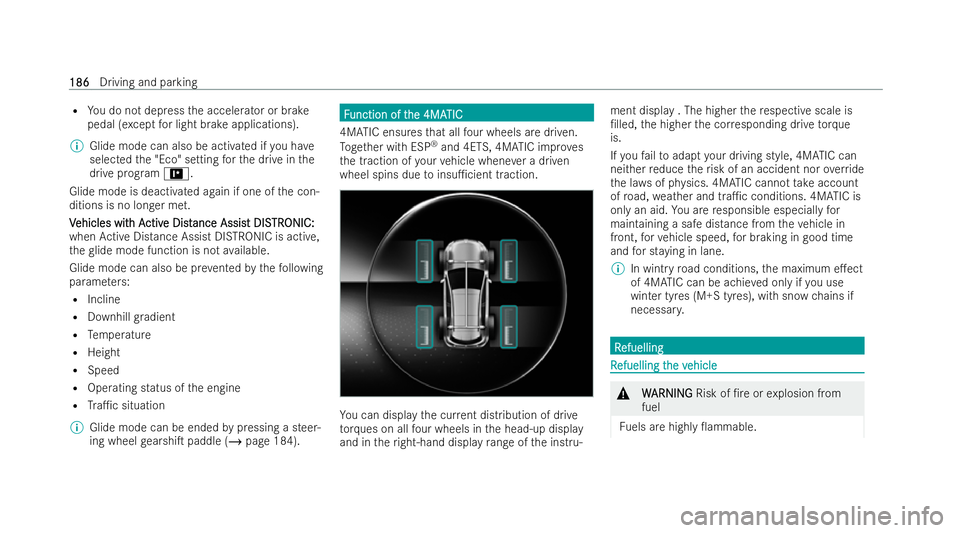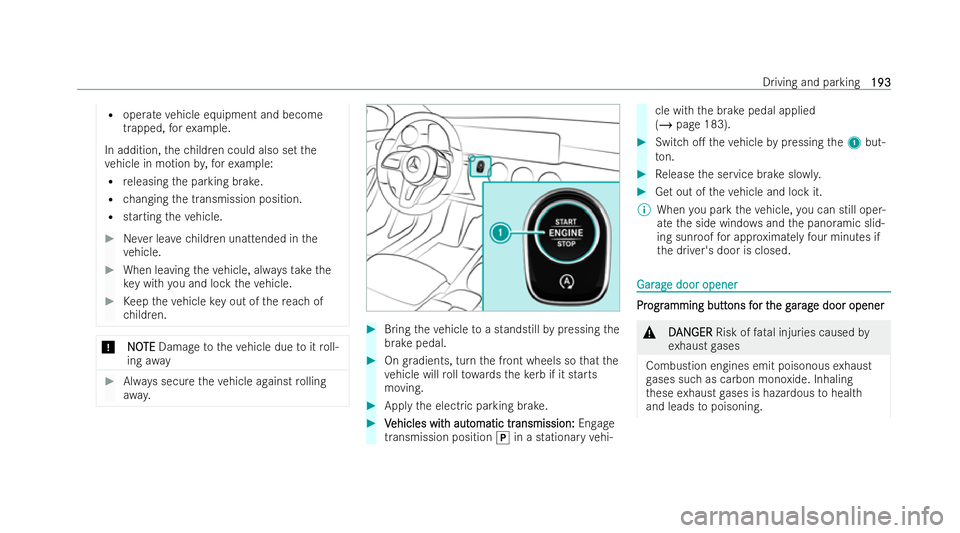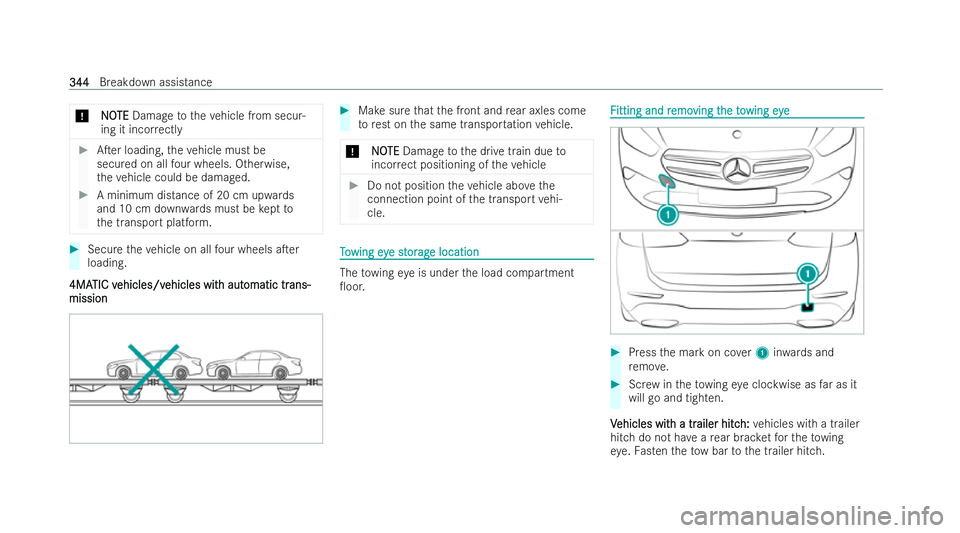Page 189 of 497

R
You do not depress the accelerator or brake
pedal (e xcept for light brake applications).
% Glide mode can also be activated if you ha ve
selected the "Eco" setting forth e drive in the
drive prog ram =.
Glide mode is deactivated again if one of the con-
ditions is no longer met.
V
V ehicles wit
ehicles wit h A
h Activ
ctiv e Dist
e Dist ance Assis
ance Assist DIS t DISTR
TRONIC:
ONIC:
when Active Distance Assist DISTRONIC is acti ve,
th e glide mode function is not available.
Glide mode can also be pr evented bythefo llowing
parame ters:
R Incline
R Downhill gradient
R Temp erature
R Height
R Speed
R Operating status of the engine
R Tra�1c situation
% Glide mode can be ended bypressing a steer-
ing wheel gearshi�T paddle (/ page 184). F
F
unction of t
unction of t he 4MA
he 4MATIC
TIC
4MATIC ensu resth at all four wheels are driven.
To get her with ESP ®
and 4ETS, 4MATIC impr oves
th e traction of your vehicle whene ver a driven
wheel spins due toinsu�1cient traction. Yo
u can display the cur rent distribution of drive
to rque s on all four wheels in the head-up display
and in theright-hand display range of the instru- ment display . The higher
there specti vescale is
�/lled, the higher the cor responding drive torque
is.
If yo ufa ilto adapt your driving style, 4MATIC can
neither reduce therisk of an accident nor override
th e la wsof ph ysics. 4MATIC cannot take account
of road, weather and tra�1c conditions. 4MATIC is
only an aid. You are responsible especially for
maintaining a safe distance from theve hicle in
front, forve hicle speed, for braking in good time
and for st aying in lane.
% In wintry road conditions, the maximum e�.ect
of 4MATIC can be achie ved only if you use
winter tyres (M+S tyres), with snow chains if
necessar y. R R
efuelling
efuelling R
R
efuelling t
efuelling t he v
he vehicle
ehicle &
W
WARNING
ARNING Risk of �/re or explosion from
fuel
Fu els are highly �0ammable. 186
186
Driving and parking
Page 196 of 497

R
operate vehicle equipment and become
trapped, forex ample.
In addition, thech ildren could also set the
ve hicle in motion by,fo rex ample:
R releasing the parking brake.
R changing the transmission position.
R starting theve hicle. #
Never lea vechildren unattended in the
ve hicle. #
When leaving theve hicle, alw aysta ke the
ke y with you and lock theve hicle. #
Keep theve hicle key out of there ach of
ch ildren. *
N
NO OTE
TE Damage totheve hicle due toitro ll-
ing away #
Always secure theve hicle against rolling
awa y. #
Bring theve hicle toa standstill bypressing the
brake pedal. #
Ongradients, turn the front wheels so that the
ve hicle will rollto wa rdsth eke rb if it starts
moving. #
Apply the electric parking brake. #
V
Vehicles wit
ehicles wit h aut
h automatic tr
omatic tr ansmission:
ansmission: Engage
transmission position jin a stationary vehi- cle with
the brake pedal applied
(/ page 183). #
Switch o�. theve hicle bypressing the1 but-
to n. #
Release the service brake slo wly. #
Get out of theve hicle and lock it.
% When you park theve hicle, you can still oper-
ate the side windo wsand the panoramic slid-
ing sunroof for appr oximately four minutes if
th e driver's door is closed. Gar
Gar
ag
age door opener
e door opener Pr
Pr
ogr
ogr amming butt
amming butt ons f
ons for t
or the g
he g ar
arag
ag e door opener
e door opener &
D
DAN
AN GER
GER Risk of fatal injuries caused by
ex haust gases
Combustion engines emit poisonous exhaust
ga ses such as carbon monoxide. Inhaling
th ese exhaust gases is hazardous tohealth
and leads topoisoning. Driving and parking
193
193
Page 347 of 497

*
N
NO
OTE
TE Damage totheve hicle from secur-
ing it inco rrectly #
A�Ter loading, theve hicle must be
secured on all four wheels. Otherwise,
th eve hicle could be damaged. #
A minimum dis tance of 20 cm upwards
and 10 cm down wards must be kept to
th e transport platform. #
Secure theve hicle on all four wheels a�Ter
loading.
4MA
4MA TIC v
TIC v ehicles/v
ehicles/v ehicles wit
ehicles wit h aut
h automatic tr
omatic tr ans-
ans-
mission
mission #
Make sure that the front and rear axles come
to rest on the same transpor tation vehicle.
* N
NOOTE
TE Damage tothe drive train due to
incor rect positioning of theve hicle #
Do not position theve hicle abo vethe
connection point of the transport vehi-
cle. T
T
o
o wing ey
wing eye st
e st or
orag
ag e location
e location The
towing eye is under the load compartment
�0oor. F
F
itting and r
itting and r emo
emoving t
ving t heto
he towing eye
wing eye #
Press the mark on co ver1 inwa rds and
re mo ve. #
Screw intheto wing eye clockwise as far as it
will go and tighten.
V
V ehicles wit
ehicles wit h a tr
h a trailer hitc
ailer hitc h:
h:vehicles with a trailer
hitch do not ha veare ar brac ketfo rth eto wing
ey e. Fasten theto w bar tothe trailer hitch. 344
344
Breakdown assistance